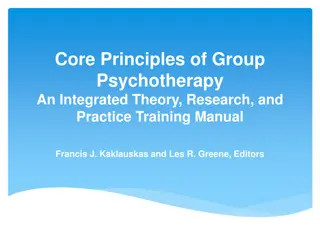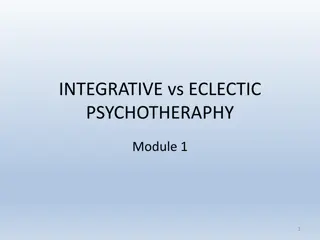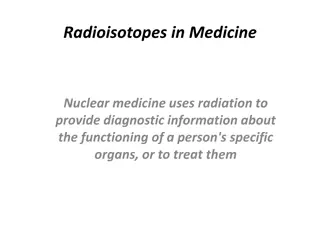Psychotherapy Phases and Diagnostic Dimensions
The psychotherapeutic process involves three phases: initial assessment, therapeutic work, and conclusion. Diagnosis plays a crucial role in understanding essential needs and coping mechanisms in therapy. Examining phases and dimensions can enhance therapeutic outcomes significantly.
Download Presentation

Please find below an Image/Link to download the presentation.
The content on the website is provided AS IS for your information and personal use only. It may not be sold, licensed, or shared on other websites without obtaining consent from the author.If you encounter any issues during the download, it is possible that the publisher has removed the file from their server.
You are allowed to download the files provided on this website for personal or commercial use, subject to the condition that they are used lawfully. All files are the property of their respective owners.
The content on the website is provided AS IS for your information and personal use only. It may not be sold, licensed, or shared on other websites without obtaining consent from the author.
E N D
Presentation Transcript
Zsolt Unoka, M.D., PhD. Department of Psychiatry and Psychotherapy Semmelweis University, Faculty of General Medicine unoka.zsolt@med.semmelweis-univ.hu
It begins when a patient first contacts a therapist, and ends at the conclusion of the therapy. The psychotherapeutic process is usually divided into three phases: The first phase begins with the first meeting and ends by signing a therapy contract. The main task of the first phase is to assess the necessity of psychotherapy, and to find the appropriate type of therapy. The second phase starts after signing the therapy contract and lasts until starting the conclusion of the therapy. This second phase takes up the lion's share of the therapeutic work. The third phase is the conclusion of psychotherapy. We start it after reaching the desired result, or when the therapy proves to be unsuccessful. The conclusion of the therapy is preparation for the prevention of relapse, as well.
The phase leading tothe psychotherapeutic intervention Getting in contact: The first impression is found to be a determining factor in many aspects of life.After the first psychotherapeutic interview, 15-17% of the patients do not go to the first session, and further 26-30% drop out after the first or second session. The discussion of the patient's ambivalent feelings about therapy can help them a lot in making a decision. Setting up a diagnosis: Psychiatric diagnosis: (DSM-IV): I. Psychiatric diseases and other conditions worthy of clinical attention II. Personality disorder, mental retardation III. Somaticconditions IV. Psychosocial and social environmental problems V. Comprehensive summaryof functioning
The most importantdimensionsof psychotherapeutic diagnosis: The abilitytofulfil essentialneeds: The positive objective of psychotherapy is to reach a state of psychic health. In the case of psychic health the person is capable of fulfilling their essential needs in a harmonic way, without restraining others by breaking the rules of social cohabitation. Example: Social needs. Affection, intimacy, sexual life, relationship, friends, workplace relations, integration into larger groups are all important elements of our lives. It is necessary for humans to feel safe in such fields and to feel that their relationships are stable. They must feel accepted and that they can rely on care from others. Inner barriers to realizing needs: Abandonment: Conviction of the patient that they cannot rely on others. Mistrust/Abuse: Others want to abuse them. Defectiveness/Shame: If their defects are revealed, they will be desolated or humiliated. Emotional deprivation: they cannot expect care, appreciation, support.
The most important dimensions of psychotherapeutic diagnosis: Coping style characteristics of personality: Coping by internalization people using this strategy believe that circumstances resulting in negative situations occur due to their own faults, whilst they form a positive image of others. Repression mechanism people using this strategy tend to avoid becoming conscious about impetuses and emotions considered to be threatening by the psychic manoeuvres of selective inattention or denial. They often fail to realize their aggression, sexual incentives or other emotions, and they only experience physiological changes accompanied by emotions. Coping by externalization Patients belonging to this group are impulsive, imprudent. They are characterized by angry outbursts. When they make a mistake they tend to blame others for their problems. Alternately external-internal coping style: Willingness for cooperation, resistance
The most important dimensionsof psychotherapeutic diagnosis: Assessmentof the degreeof motivation Pre-contemplation the phase before contemplation: The patient does not recognize the problem, is not willing to change it. They deny the existence of the problem and believe it is related to others. Contemplation: The patient has already realized the problem, and is considering a change. However, they have not committed to change. Ambivalent Phase of preparation: In this phase, the patient has already considered the possibility of change. Phase of taking action: Patient starts making changes. They start to change their behaviour, appraisal of situations, or they start to reshape their environment. Phase of maintenance of the changes achieved: The objective is the solidification of results achieved. In this phase, a particularly important task is to prevent relapse. Phase of relapse to a previous level: In most cases, changes are not linear, they usually take place in spiral cycles.
Firstpsychotherapeutic interview The first therapeutic interview leads to the first case conceptualization which is shared with the patient. Caseconceptualization It is a starting point from which the therapist creates hypotheses about the risk, the causal and the sustaining factors of the psychic, social and behavioural problems of the patient. Therapycontract As a result of the first case conceptualization, the therapist must be able to make a decision on the necessity of the therapy, its location, method, duration, frequency and its realistic goals.
The first few sessions (3-7 sessions) are momentous. Changes coming about during the first sessions are decisive in regard to the outcome of the therapy. 65% of the patients show a measurable improvement by the 7th session. When no improvement is reached in the beginning or the condition deteriorates by the third session, half of the patients quit therapy before time, or report the treatment to be ineffective at the end of the course. Consequently, when no improvement is made at the early stages, then case conceptualization must be recommenced, and the treatment needs to be adjusted to the needs of the patient.
Numberof sessions: Behaviortherapy: 1-7 Cognitive-behavior: 20 Psychodynamic: 20-100 Psychoanalysis: 400-1000
The following conditions must be met to start to end the therapy: a considerable improvements has taken place in achieving the treatment goals the patient is able to practisethe skills they acquired during the therapy in solving their problems changes can be experienced in the central relationship patterns of the patient Main steps of the conclusion the therapy: Suggest the opportunity for concluding the therapy (preferably, conclusion should not take place in the session when the idea emerges) Discuss the date of the last session Strengthen the skills and lessons learned by the patient throughout the therapy Prepare the patient for the prevention of possible relapses
The effectiveness of the psychotherapeutic process can be evaluated based on the following four aspects: Number of symptoms decreases and/or abilities to tolerate (tolerance) effects of symptoms increases Adaptive capacities increase Consideration Insight increases Basic conflicts, patterns are solved, or become treatable























